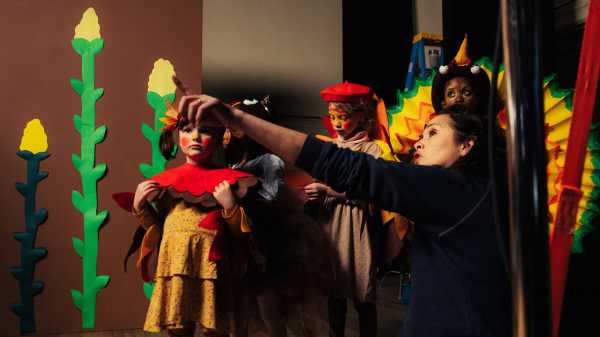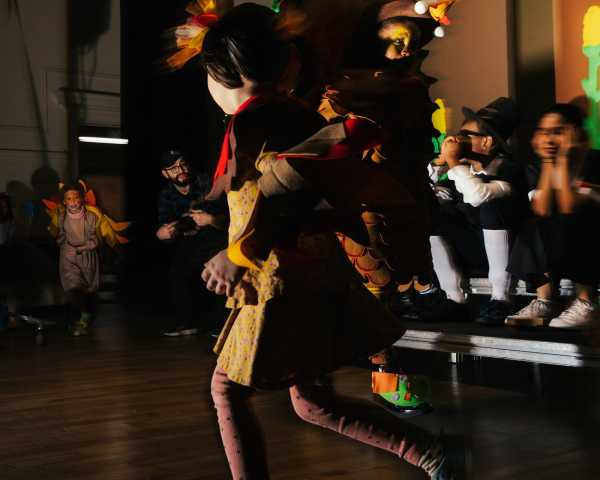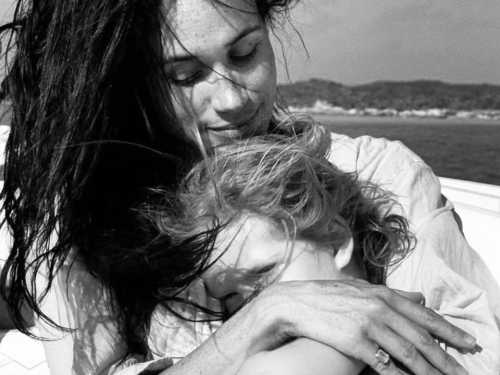
On Thursday, the playwright Larissa FastHorse will become the first Native American woman to have a play produced on Broadway. In “The Thanksgiving Play,” a satire that has already been staged across the country, four performers struggle to devise a school pageant that is historically accurate and respectful of Native peoples but won’t leave the audience feeling terrible—a tall order, presented comedically, that the characters may not be able to pull off.
FastHorse, who belongs to the Sicangu Lakota Nation, recently spoke with the New Yorker theatre critic Vinson Cunningham for The New Yorker Radio Hour. A former ballet dancer, FastHorse worked in film and television before moving to theatre, and became a MacArthur Fellow in 2020. In addition to playwriting, she is a co-founder of Indigenous Direction, an organization that counsels film and theatre productions on how to incorporate Native themes. She and Cunningham discussed race in casting, writing for “well-meaning” white audiences, and the practice of land acknowledgments before performances. FastHorse opened the conversation, which has been edited for length and clarity, by sharing details about her upbringing.
“I grew up in South Dakota, where my Lakota people are from, but I was adopted at a young age, an open adoption to a white family who had worked on the reservation for a long time, the reservation where I’m from,” she said. “I was always raised very aware of my Lakota identity and my Lakota culture, and they brought a lot of mentors into my life, and elders, to help me stay connected. But, at the same time, I was growing up in a very white culture. My first career was in classical ballet, so it doesn’t really get much whiter than that. I don’t know—maybe opera? I’m not sure.”
There’s a list. Ballet is on the top. [Laughs.]
They’re way up there. Ballet’s in the top five. So, at the time, when I was younger, it was very painful, to be separated from a lot of things I felt like I couldn’t partake in because I wasn’t raised on the reservation, or I’d been away from my Lakota family so long. That was very hard, but now I really recognize it as my superpower, that I can take Lakota culture and experiences and contemporary Indigenous experiences and translate them for white audiences—which, unfortunately, are still the majority of audiences in American theatre.
I do want to go back to ballet, because it does seem like this really important part of your life, that you are a professional ballet dancer. How much did your training as a dancer stay with you? Is that a part of your approach as a writer? Do you think about that often when you’re working?
Oh, yes. My ballet background is hugely influential in my work as a playwright. First off, just in the work ethic. Ballet dancers are expected to be shown something once, and then you work on it on your own and you come back and you’ve got it down. People aren’t going to sit there and spend a lot of time spoon-feeding things or teaching you one thing at a time. You’re expected to learn it, to do your own training at night, after six hours of classes and rehearsal. You’re expected to do a lot on your own, and that kind of work ethic certainly has helped me as a playwright, where you spend months, sometimes, alone in your home writing, and you could miss that deadline. No one’s gonna yell at you. But, also, you can really see it in my writing. There’s a lot of movement-based acting [and] text-free scenes in my work.
“The Thanksgiving Play” is a perfect example. There are several scenes that have little to no text, that are movement-based, and they are moving the story forward. They’re essential to the story, but without using text, or very little text, and a lot of movement and gesture. And then I’d say, also, as far as my process, I was trained primarily in the George Balanchine tradition. His way of working with dancers and his choreography was to change it all the time, depending on who he was working with. So when I’m in the room with actors, like I have been here in New York for the past couple of months, I’m constantly adapting my work to that group of people, so it highlights their strengths and is perfect for them. So my work is always changing when I’m in the room.
So, “The Thanksgiving Play”: it’s about four people who, let’s say, present as white. They’re trying to put on a play about the first Thanksgiving, and often failing to acknowledge this Native presence that they are somehow trying to highlight. I was thinking a lot about what’s happening in Florida, about how we educate our children about topics that might make them feel guilty or upset. How much of today’s dramas over education and race and history were you thinking about with this new production?
Oh, a lot. I definitely have updated a lot for the times. It’s interesting you mentioned Florida. The laws state, if something causes—I think it’s guilt, discomfort, or anguish, based on your race—it can’t be taught in a school. You’ll hear those words in the play if you come to it. I wanted to make sure that these people—’cause they are, I call it “performative wokeness”—these are white folks, liberal folks, trying really hard to do everything right, and, as you said, getting everything wrong. I wanted to make sure that they’re people of today and not someone who you can look at—I don’t want people to be able to say, “Oh, well, since 2020 we’ve changed, so this isn’t me.” Because it definitely still is. But, interestingly, one of my first writing mentors was the great Merata Mita, who is a Maori writer and filmmaker from New Zealand/Aotearoa, and she said to me, on my very first screenplay that I wrote before I was writing plays, she said, “Larissa, you can be an artist or you can be an educator. If you try to be both, you’ll do one of them badly, so you have to pick one.” I chose artist, and she said, there’s certainly art that educates, and there’s education that’s artistic, but you have to choose which one you are and stay true to that.
I imagine that that tension is exacerbated by the expectations of the audience. Just the way the arts happen in America—usually the audiences are white, right?
Right.
And I think it’s fair to say some people come to the theatre on some level hoping to have some sort of educational experience, as opposed to art. What I love about your play is that it’s, like, “No, you’re just gonna laugh, and it’s gonna feel weird.” Is that something that you like to play with, or is it something that feels like a hurdle?
No, absolutely. I love that.
One thing I love about this play: there’s a character named Alicia, and she’s played by D’Arcy Carden, a very funny, wonderful performer. And she’s hired on the assumption that she is a Native person. I thought about this because, in a lot of the literature that I was raised on—Black literature—passing is a big theme. What does passing mean to you, onstage and off?
I am white-passing, in many ways, and yet at the same time, before I was writing, when I was acting for a while, the casting directors said to me, “We can tell you’re not completely white, and that’s a problem.” I was, like, Wow, O.K., I’m done. There’s nothing I can do about that.
Is that America’s subtitle? Is that perhaps the whole thing?
Yes, that should be the little subtitle underneath. “United States of America: We can tell you’re not white, and it’s a problem.” [Laughs.] I am very light-skinned, and, again, it was something that was sometimes painful, because colorism, you know, is a thing in our communities, and it was sometimes painful that I was so light and white-passing, growing up with a lot of full-blood [people]. My father is full-blood, and [he’s] much darker, my biological father. So I had some pain over that, growing up, and especially because then I was raised away from it. It was, like, who are you, showing up again? However, on the other side, on the white side, which is, like, American theatre, I am quite sure that I get into rooms that not-white-passing Native people would not get into.
The other thing about Alicia is that she’s brought in specifically not just to be an actorly presence but, like, “We’re going to use her expertise” and “What do you have to say? Please tell us.”
Mm-hmm. The “wisdom.”
I would imagine that that has some corollary to your experience?
Oh, it’s exhausting. [Laughs.] I always say I just can’t imagine what it would be like for a white male playwright: like, they just walk into a theatre and they’re just a playwright, and they don’t do anything else. I can’t imagine what that’s like. I’ve never done it because, you know, I’m so fortunate with the career I’ve had, but I’m also the first one in ninety per cent of the places I’ve worked: the first one in this theatre. First one in. It just goes on every step. I’ve got six shows this year, and, [with] most of them, I’m the first Native American. I guess this is the privilege of being the first: it means that I also have responsibility. I do what I call “Indian 101,” that all of the staff has to come to, including front of house, box office, production, everybody, to help them understand Indigenous culture, the space they’re standing in, and, most importantly, our audiences that we’re hoping to welcome into the theatre. How do we welcome them, understanding that theatre is a white culture? Western, American theatre is a white culture. The assumptions you’re making of what’s acceptable behavior in theatre are completely different from what is normal behavior in so many cultures on this continent.

Actors rehearse a scene in “The Thanksgiving Play.”Photograph by Justin J. Wee
“The Thanksgiving Play” spotlights so many [elements of] theatre and says, well, do we really mean that? I think we’ve all settled into an orthodoxy of “You can’t play outside of your race and ethnicity, your look.” But, of course, what that means is if there aren’t Indigenous roles to play, Indigenous actors are never able to do that act of representation. In your experience working with actors, how have people started to think about that?
That’s interesting, because casting is still very complicated. Redface is being done regularly all over our country, on film and TV, on stages. There are so many non-Indigenous actors still playing Indigenous roles, and there are so many people calling themselves Indigenous that cannot in any way prove they’re Indigenous and have no actual connection to any Indigenous community playing Indigenous roles. People say they understand more, and they’re doing better, and yet redface is being done constantly. Conversely, fascinatingly, if you read the script of “The Thanksgiving Play,” I put in the character description that people of color who can pass for white should be considered for roles. And I was really proud of that. But, when I get to New York, we were told we can’t put that in the casting breakdown: “Well, you can’t ask people to play someone else.” I was, like, “Wait, there are still white people on these stages in New York City right now, playing Native, but you’re saying I can’t openly have nonwhite people play white people if they look white to you?” And they’re, like, “No, you absolutely can’t.” I’m not allowed to ask people if they’re Native American when they’re being cast, and so we have to do this whole kind of song and dance of, I try to figure it out by chitchat, and then people get all mad because we cast someone and it turns out they weren’t Native, or they didn’t have a connection to the community. It’s this constant thing, which is all part of what we’re dealing with in “The Thanksgiving Play.”
One way of interpreting the show is that it’s about the most far-reaching implications of meaning well. It seems to me that the people that are gonna come to Broadway shows are these same well-meaning people. [Laughs.] What has been the response to that: “This is kind of you”?
Oh, it’s absolutely you. I do not hide that. I don’t hide the fact that this is about white, liberal folks, [who] tend to be theatregoers. Not at all. The thing that I keep saying, that has been very important to me in this play, is, first, it’s fun, and you get to have a good time in the theatre. And, second, I would say that’s the sugar, and then there’s the medicine. It’s satire. It’s a comedy within a satire. So the satire is the medicine, and you have to keep taking it, and, honestly, some people opt out. We’ve had a couple of people walk out.
Really?
Once it got too far in, they’re just, like, “No, this is too much.”
I can imagine one, at least one scene where that might happen.
Yeah. But the vast majority of audiences are really raucously responsive, and really having a fun time. Last week we had audience members talking to the stage—like, talking back—and it just got wild. They added, like, six, seven, eight minutes to the show.
Whoa.
Yeah. It was crazy. It was a lot of talking and chatting and clapping and responding. But we love that.
Something that I’ve wondered, because I think most people who live in Manhattan think about the Lenape only before a show or something. Someone comes out and does a land acknowledgment and says, “This is the land of the Lenape people.” How do you feel about that practice?
Land acknowledgment, honestly—I know in some places we’re getting a little tired of it, but I will say it’s definitely not everywhere, and it’s not all facets of the society. So I’d say, for me, until everybody in the United States of America can name the Indigenous land they’re standing on, we need to keep doing it. But I would say, too, land acknowledgment is a step. It’s the first step of many steps of reparation. If you can’t name who you’re supposed to be paying reparation to, you obviously can’t even begin. So you have to at least know who reparations are owed to for the land that you’re on, who you are paying rent to. You need to know that, and then you need to start paying the rent.
Thank you so much for doing this.
Of course. Thank you. ♦
Sourse: newyorker.com






